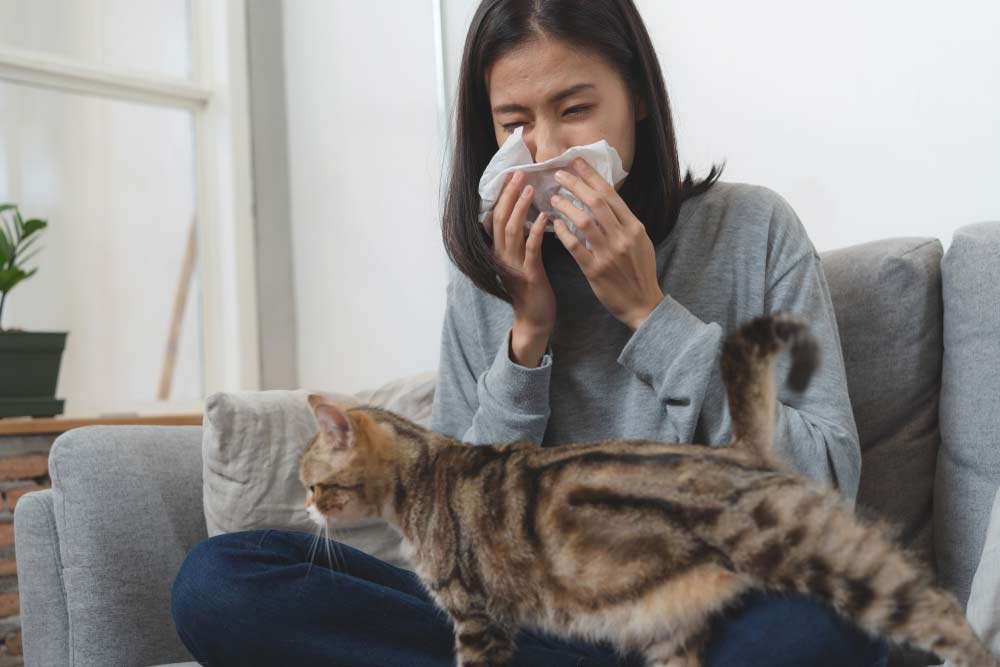
Hypoallergenic Cats: The Best for You
There are dog people and there are cat people. Then there are people with allergies to cats or dogs, and these categories don't always align the way they should. In a perfect world, people who do not like pets would be the only ones with allergies. Unfortunately, that just isn't the case. If you would love to share your home with a pet but your allergies are persistent, you are not alone! Luckily, there are hypoallergenic cats.
Plenty of people are in the same boat. In fact, cat allergies are twice as common as dog allergies, according to the American College of Allergy, Asthma, and Immunology. Fortunately, there are alternative cat breeds that are less likely to trigger your allergies. The best cats for sensitive allergies are known as "hypoallergenic” cats. We'll explore the top breeds of cats that may not trigger your allergies.
What Causes Cat Allergies?

A common misconception is that pet allergies come from fur. This is only indirectly true, as they are actually derived from a protein found mainly in the cat’s saliva, but also in the sweat and urine. The Fel D1 protein is to be blamed, and it winds up covering cats’ fur when they lick themselves clean. When their fur is disturbed or shed, dead skin cells (known as dander) are released, distributing the protein. The dander particles are so small, they can remain airborne for long periods of time with the slightest bit of air circulation. All cats produce Fel D1, but not at the same rate. This is where the good news for cat lovers with allergies comes in.
Those who are allergic can choose a cat that naturally produces less of the Fel D1 protein. For example: young, female, and fixed cats produce less of the protein than males, and those who are not neutered. Certain breeds also naturally produce less than others.
Keep in mind that while you may not be directly allergic to cats, being around them can still cause allergies to flare up indirectly. Their fur clings on to outside irritants such as pollen, mold, dirt, etc. Nasal irritation can also arise simply from floating hair and dander particles. A low-shedding type of fur may be a good idea to keep in mind for those looking to keep their allergies at bay.
Best Cats for Allergies
Here are the most hypoallergenic cat breeds to look out for, or to find charming mixes who share these breed roots and traits.
1) Balinese Cats
Balinese cats are a long-haired mutation of siamese cats. They are one of the best known hypoallergenic breeds for cats, despite their silky coats. They are said to produce less of the Fel D1 protein, so their fur and kitty licks are less likely to cause an allergic reaction.
Temperament:
Balinese cats are known to be smart and sweet. They are playful, and like siamese cats, they are prone to vocalizations. Your Balinese is likely to be affectionate and talkative.
Care:
Balinese have luxurious long-haired coats, however they remain relatively low maintenance. They do not require a lot of grooming because they have no undercoat, and they do not shed frequently. They have a long average lifespan of about 15-20 years.
2) Javanese Cats

Javanese cats are a charming cross between Balinese and Colorpoint Shorthair. They are one of the lowest shedding cat breeds known in the world, and are extremely low-maintenance. They also produce a lower amount of the Fel D1 protein, and therefore favored as a hypoallergenic breed.
Temperament:
You will never be lonely with a Javanese cat. These cats are known to be energetic and communicative, as well as intelligent. Javanese cats are very playful and affectionate, so expect your cat’s personality to be well-rounded. The Javanese will make anything their playtoy, and they will show off their powerful jumping skills.
Care:
Javanese cats have short hair with no undercoat, which contributes to their extremely low rate of shedding. They require little to no brushing or bathing to stay neat and don't leave your furniture covered in cat hair. The average lifespan of the Javanese cats is approximately 8- 12 years.
4) Sphynx Cats
Sphynx cats are the most popular hairless cats. As we know, fur is not the main cause of allergies and these cats still produce a normal amount of the Fel D1 protein. However their lack of fur might make it easier for those who get the sniffles due to excess fur and the irritants it can typically carry. This makes them a mixed choice when seeking a hypoallergenic cat. A Sphynx is a great choice if you are worried about shedding, but do not solve all cat allergies. Keep in mind they still shed Fel D1 in other ways.
Temperament:
Sphynx cats are playful, outgoing, and intelligently mischievous. Be prepared to give your Sphynx lots of attention; they will follow you around with devotion, but will also get into trouble to get your attention. Some may be a bit demanding.
Care:
Sphynx cats need to be bathed regularly to wash oil that builds up on their hairless skin. Bathing can also remove the saliva dander that causes allergies for a short-term solution.
5) Devon Rex Cats

The Rex cat breed variations all produce lower Fel D1 protein and have a low-shedding profile, making the perfect choice for a household prone to allergies. Devon Rex cats have curly, adorable short-haired coats. Their fine coat is rare among most breeds. What’s nice is that this type of coat hardly sheds. Other distinctive features are their slender build and larger, pointed ears.
Temperament:
Devon Rex cats are very affectionate and people-oriented. They are often just as playful as they are cuddly. Quite like a dog’s personality, involved in whatever you are doing. Keep a close eye on these cats as their playfulness can sometimes get them into trouble.
Care:
Devon Rex cats require very little care. Their light coats hardly shed, but you should regularly wipe their ears and paw pads of oil buildup.
6) Cornish Rex Cats
Cornish Rex cats are small to medium- sized cats. They only have an inner coat consisting of short hairs, and no top coat. Their fur is very fine and wavy, and sheds at a very low rate. Although they appear slender, they are also very athletic.
Temperament:
Cornish Rex cats are very affectionate. They are physical and love to share a warm lap, partly because they have less fur for insulation. Cornish Rex are sociable and love to be the center of attention. They love being handled by their parents.
Care:
Cornish Rex cats need frequent bathing to help remove oil buildup on their skin. They love to jump and play, and need enough space for exercise. They need interactive exercise as well, as with most cats.
7) Russian Blue Cats

The popular Russian Blue cat breed is indeed hypoallergenic. Russian Blues have fine, gray fur that feels soft and plush. These gentle cats are well-known to be compatible with sensitive allergies, as their coats shed very little. Along with this, they produce lower amounts of Fel D1.
Temperament:
Russian Blues have sweet-tempered and loyal characteristics. They follow their parents everywhere! While they are cuddly, Russian Blues have a social battery and value their alone time to recharge. They tend to shy away from visitors and large gatherings.
Care:
Russian blues don't shed much, but love a good brushing. They are highly intelligent and require both physical and mental stimulation. Make sure they have plenty of toys, especially ones that encourage their natural hunting instincts.
8) Oriental Shorthair Cats
Oriental Shorthair cats are a combination breed with expressive features and slender frames. Their distinctive short hair requires minimal maintenance, and can be any color from 300 different shades! They are closely related to Siamese cats, as shown by their wide ears.
Temperament:
Oriental Shorthairs are charming and energetic. They like to explore, play, and can be quite attention-seeking. This talkative breeds has a distinctive cry, commonly referred to as a honk. They are very social and love to be around both people and other cats.
Care:
The Oriental Shorthair cat is low-maintenance and typically only requires occasional brushing to reduce indoor shedding. They thrive in both homes and apartments, and always need a friend in sight. Many owners get their Oriental Shorthairs a buddy.
9) Siberian Cats

If you live somewhere cold, the Siberian cat is a wonderful choice of hypoallergenic cat breed. These medium to large-sized cats have various color patterns and shadings. Siberians produce significantly less Fel D1 protein in their saliva while offering the fuzzy joy of a beautiful long-haired cat.
Temperament:
Siberians are intelligent and loving cats. They are explorative, playful, and capable of figuring out doors and food puzzles. Siberian cats are also cuddly and known to be gentle with children. They love their parents but aren't shy around strangers.
Care:
Siberian cats do have a triple coat that requires regular brushing. Expect heavy shedding in the summer and to groom often. but they are well-known not to set off cat allergies.
Shelter Cat? Spend Time Together to Find Out
Of course, cat breeds today are only general guidelines. Instead of seeking out a pure breed, look to local shelter adoption for cats who share a lineage with low-Fel D1 producers and short-haired cats.
When you can't be sure - as with most rescued cats - spend time with the cat. You should do this regardless of where you buy your cat, since everyone is different. Find out which cats you can snuggle without sneezing. Know that there are so many breeds that may not set off your allergies. Finding a cat that you can comfortably take home is a journey, and you’ve started in the right place.

Join Our Pack
Follow us @NaturVet on social media to fill us in on tips we might have missed. And, check out the rest of NaturVet.com. We’ll keep you up to date on all our latest pet resources, supplements, tips and tricks, and more – everything you need to be the best pet parent possible!






